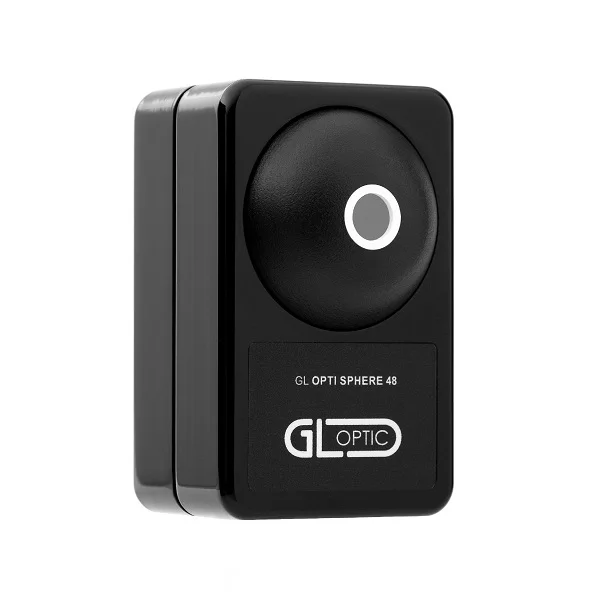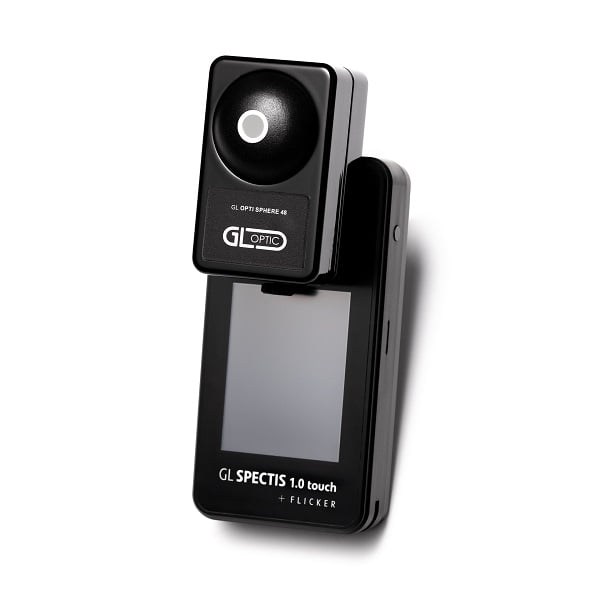Any questions or would you like to order this product? Do not hesitate to contact us
Product categories
Filter the products and categories by showing only certain partners.
Truly accurate flux for single LEDs
The GL OPTI SPHERE 48 is an attachment that integrates spheres with our GL SPECTIS spectrum light meters to measure the luminous flux of small light sources, such as LED chips. An optimal distribution of light and accurate lighting power measurement are made possible by this integrating sphere. Utilize this for LED luminous flux, radiant power, color coordinates, color temperature CCT, and color rendering qualities (CIE CRI; IES TM-30).
This accessory is very easy to use and is a great tool for electronics experts and producers of LED modules in their daily job. When choosing the right parts or needing a fast and precise LED measurement, this is also highly useful for buying managers and agents.


Plug & measure
With the direct mounting of this tiny integrating sphere on the spectrum instrument, the user can obtain precise and instantaneous photometric and radiometric data. Your GL SPECTIS device’s measuring capabilities are extended to single LED readings by the spectrum meter’s automatic detection of the RFID code.
Lab performance in your hand
By using this device, you may obtain findings that can be traced back to laboratory standards. This allows you to manage the binning (color and flux groups) during the initial selection stage or make more informed decisions about the quality of the LEDs and the items you require for your development. Asking the laboratory to measure these for you is no longer necessary.
Confidence and flexibility
Purchasing various kinds of LEDs or collaborating with multiple vendors? These days, you can quickly and simply examine the color and light output of these parts. Take it a step further and conduct in-depth analysis at every level of development by combining it with the potent GL SPECTROSOFT analysis package.
GL OPTI SPHERE 48 Usage
More than ten years ago, our chief engineer informed our development team, “We need to make a tool that will be easy to use and immediately show accurate results of a single LED,” while they were working on next-generation LED-based lamps for color evaluation. Before we place these LEDs in the prototype module, we need to know the light output and quality. Since then, it has developed into a crucial tool for electronic developers working on LED lighting, who frequently battle with issues like driver selection, LED output optimization, and module and LED output optimization. Rather than choosing the right LEDs for development projects only on the basis of samples and the datasheet, you may use this sphere to rapidly confirm binning, validate performance, and see if samples are meeting specifications. Once your new module has been tested, all you need to do is place the sphere on top of each LED to see how much light it produces. For LED strips, the same applies. For GL optics, utilize our spectral integrating sphere in conjunction with various spectral instruments. See how our PASS/FAIL and GL SPECTROSOFT binning functions can assist you in your business.
GL OPTI SPHERE 48 Features
Apertures for different size LEDs
Don’t be fooled by the modest size. Anywhere you need it and for any purpose, this scientific-grade handheld equipment is simple to set up with various apertures to measure light flux correctly. For some situations, a fiber-optic adaptor is also an alternative.
Extended dynamic range
An optional high-signal adaptor, suitable for various luminous flux levels, can be used to measure high-output LEDs.
Special accessories for QC
Use a remote trigger device that has an indicator bulb to show when a measurement is finished for production or quality control applications. ideal for a trade floor that is noisy. For additional automation, use GL SPECTROSOFT or customer software via the API.
GL OPTI SPHERE 48 Metrics
- Lumen: luminous flux
- CRI: color rendering index according to the CIE
- CCT: the color temperature according to standard CIE
- Color: the chromatic coordinates of the CIE 1931 and CIE 1964
- Fidelity and Gamut: method for evaluating light source color rendition according to TM-30 IES standard
- PAR/PPF: photosynthetic active radiation measurements for horticulture
- mWatt: radiation energy
+ many more!
PDF and available downloads
You can download the information on this page and the available downloads as one PDF file. There are 2 downloads available for this product.
Enter your email address once to gain access to all downloads on the PEO website.
There are 2 downloads available for this product.






